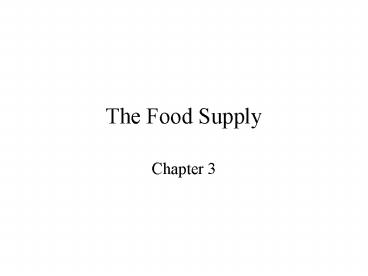The Food Supply - PowerPoint PPT Presentation
Title:
The Food Supply
Description:
The Food Supply Chapter 3 * Health Consequences of Food Insecurity Physical and mental activity declines Growth slows or ceases Muscle and fat wasting Immune system ... – PowerPoint PPT presentation
Number of Views:144
Avg rating:3.0/5.0
Title: The Food Supply
1
The Food Supply
- Chapter 3
2
Health Consequences of Food Insecurity
- Physical and mental activity declines
- Growth slows or ceases
- Muscle and fat wasting
- Immune system weakens
- Increased disease susceptibility
- Death
3
(No Transcript)
4
Food Insecurity in the U.S.
- 15 of households are food insecure
- Closely linked to poverty
- 13 live at or below the poverty
- 1/3 are children
- Ethnic groups
5
(No Transcript)
6
Programs to Increase Food Security in U.S.
- Supplemental Nutrition Assistance Program (SNAP)
- Food Stamp program in some states
- Special Supplemental Nutrition Program for Women,
Infants and Children (WIC) - National School Lunch Program
- School Breakfast Program
- Child and Adult Care Food Program
- Programs for seniors, food distribution programs,
private programs
7
Organic Foods
- Allowed
- Biological pest management
- Composting
- Manure applications
- Crop rotations
- Not allowed
- Synthetic pesticides, fertilizers and hormones
- Antibiotics
- Sewage sludge
- Genetic engineering
- Irradiation
8
Biotechnology
- Recombinant DNA technology
- Genetically modified (GM) foods
- Common crops
- Cloned animals (currently not approved for
consumption) - Uses
- Pest and weed control
- Disease prevention in plants
- Increased crop yields
- Recombinant bovine growth hormone (rBGH)
- Future possibilities
- Increased nutrient density (golden rice)
- Pharmaceutical production
9
(No Transcript)
10
Regulation of GM foods
- FDA
- Safe for humans and animals to consume
- USDA
- Crops are safe to grow
- EPA
- Pesticides introduced into foods are safe for
consumption and the environment
11
Many inferior food products were marketed under
so called distinctive names before passage of the
Food, Drug, and Cosmetic Act of 1938. These
productswere heavily advertised, and were of low
quality.
- Prompted by increasing concerns over the use of
untested chemicals as food preservatives, Harvey
Wiley, M.D., chief chemist of the Agriculture
Department's Bureau of Chemistry, set out to
investigate whether such preservatives should be
used in food and which quantities were safe.
Congress appropriated funds for the studies in
1902. - Wiley recruited volunteers, which the press soon
dubbed the Poison Squad. The young men ate foods
containing measured amounts of borax, salicylic
acid, formaldehyde, and other chemical
preservatives. He stopped each unconventional
experiment after many of his volunteers became
sick. According to anecdotal reports, none of the
men was permanently harmed. - In the end, Wiley advocated that chemical
preservatives should be used in food only when
necessary, that the onus of safety should be on
the producer of foods, and that consumers should
be informed about ingredients on food labels--the
basic elements of current food laws and
regulations.
12
Safety Concerns of GM Foods
- Allergens
- Unintended gene flow
- Development of Bt resistant insects
- Loss of genetic diversity
- Insufficient regulation and oversight
- Other unknowns
13
Food Preservation and Processing
- Food irradiation
- Radiant energy to extend shelf life and control
growth of pathogens - Food additives
- Intentional vs. incidental
- Synthetic vs. natural
14
Uses of Food Additives
- Improve freshness and safety
- Enhance or maintain nutritional value
- Enhance or maintain color and flavor
- Contribute to functional characteristics
- Examples texture, acidity
15
Regulation and Safety of Food Additives
- Prior-sanctioned substances
- Sodium and potassium nitrates
- GRAS list (generally recognized as safe)
- Vanilla, salt, sugar..
- Review can lead to deletion of additives on list
- Food Additive Safety Tests in animals for FDA
approval - Sucralose
- Stevia
16
(No Transcript)
17
Water Safety
- Public water regulated by the EPA
- Bottled water regulated by the FDA
- Threats to water safety
- Agricultural runoff
- Inappropriate disposal of chemicals and municipal
solid waste - Inadequate treatment of human wastes
- Pollution from boats/ships
18
Lead and Dioxins
- Lead
- Toxic, used in paint prior to 1986
- Herbal remedies and mineral supplements, some
imported canned goods, and painted toys - Iron deficiency increases lead absorption
- Dioxins
- Byproducts of industrial processes
- Accumulate in animal fat and fish
- Cause liver and nerve damage
- EPA restricts use of fish from certain waterways
19
Mercury and PCBs
- Mercury
- At risk children, pregnancy and lactation
- Avoid and limit certain types of fish
- Controversial, because good source of omega 3
fatty acids
- PCBs
- Were used in industrial processes
- Residue on primarily freshwater fish from
contaminated waterways
20
Pesticide Regulation and Exposure
- EPA, FDA and USDA all regulate pesticides
- Pesticide tolerance
- Minimizing exposure
- Infants and children most susceptible
- Washing and peeling all produce
- Trimming away fat on meats
- Certified organic foods
- May still contain some residual pesticide
21
Antibiotics
- Used to promote growth in animals and
prevent/treat disease - Concern with antibiotic resistant bacteria
- Not used on organically produced animals
- http//www.opb.org/artsandlife/article/npr-surpris
e-organic-apples-and-pears-arent-free-of-antibioti
cs/































